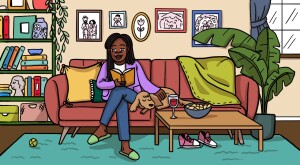Tammi Lawson is in her element as the curator of the Art and Artifacts Division at the Schomburg Center in Harlem, perhaps the most recognized Black research institution in the world. Here are yellowed copies of Malcolm X speeches, Gordon Parks photographs and Althea Gibson’s tennis whites adjacent to a thoughtful mélange of album covers, manuscripts and handwritten letters. Fifty years before most other Black institutions started their collections, Lawson explains, as far back as the early days of the Harlem Renaissance and the Works Progress Administration program that employed writers like Zora Neale Hurston, the Schomburg Center, then the 135th Street branch of the New York Public Library, became a time capsule of our artists’ careers.
It’s Lawson’s job to select and preserve works of art that tell the story of the Black experience throughout the diaspora, a personal passion that she regards as an honor. As tourists pause to take pictures or read placards, Lawson points to items and describes them with an easy, conversational expertise.
“Ourcollection has more than 15,000 items, mainly in African art, fine art, material culture and ephemeral materials. But we document anything visually by and about people of African descent,” she says, careful to distinguish the Schomburg from a museum. “Although we serve academics, we serve the layperson, too. We want the community to be comfortable and to get knowledge.”
She stands next to “Gamin,” an early sculpture in painted plaster by Augusta Savage, an extraordinary artist, a teacher and the pioneering owner of the first gallery to sell Black art in Harlem. The Schomburg has the largest public collection of Savage’s work. Lawson says she’s especially proud to highlight Black women artists.
“Black women are fierce and pragmatic. We get things done and we fight for what we believe in. If nothing else, Black women got other Black women’s backs. We’re often left out, but we thrive,” says Lawson. “Black women artists have been creating even before being recognized for their artistry — in the home, in the kitchen making meals out of scraps, making fabulous quilts out of tossed-off clothing and material. What Black women artists do well,” she adds, “is create images that look upon us favorably, doing and being all sorts of things, adding tenderness, love and dignity.”
For Lawson, 54, a mother of two twentysomething children who earned a master’s degree in library science with a specialty in preserving cultural heritage materials from Queens College, working at the Schomburg is a dream job. A native New Yorker raised in a Black enclave on Staten Island, she was exposed early to art at the Metropolitan Museum of Art and other museums. But in school she learned nothing about art created by people who looked like her. That changed when she was an undergrad in a City University of New York class taught by author, poet and journalist Quincy Troupe.
“We had to do a paper and he suggested I come to the Schomburg. When I got here, I was blown away,” Lawson says. “I was like, ‘This whole building is all on Black history? What?’ I had to work here.” In 1989, she accepted a job as a library technical assistant,and shortly thereafter, her boss, Deirdre Bibby, began grooming Lawson to take over as curator. Lawson doesn’t only collect work from well-known figures, she advocates for all Black artists. For each artist in the collection, she develops a file that researchers or curious holders of a library card can examine by appointment.
Visitors come from all over the world to gaze at Aaron Douglas’ four-mural series “Aspects of Negro Life,” a must-see for anyone studying the Harlem Renaissance, Lawson says, and “Ira Aldridge as Othello” by Pietro Calvi, a 1,000-pound marble and bronze sculpture that most people think is a Black Jesus. What speaks to her personally are “African Venus” and “Said Abdullah,” both 19th-century bronze sculptures by French artist Charles Cordier, donated by Arturo Schomburg, the institution’s founder. Lawson says the mastery and dignity of these two works move her.
Privileged to work in a shared space where Blackness is affirmed, Lawson stretches herself culturally. “The people who work here are from Russia, Cuba, the Dominican Republic, Puerto Rico. We have the whole of Africa here as well,” she says. “I’m surrounded by Black excellence. I’m continually learning from my colleagues, and I’m always trying to do the best for my people.” She smiles and adds, “I didn’t discover being Black and proud. I was raised that way. So this, where I’m at, aligns with my being.”

Kareem Black (Makeup Artist: Kayla Lawson)












